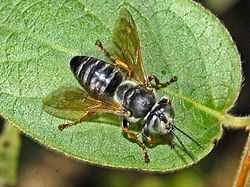| Tachytes | |
|---|---|
 | |
| Tachytes etruscus | |
| Scientific classification | |
| Domain: | Eukaryota |
| Kingdom: | Animalia |
| Phylum: | Arthropoda |
| Class: | Insecta |
| Order: | Hymenoptera |
| Family: | Crabronidae |
| Subfamily: | Crabroninae |
| Tribe: | Larrini |
| Subtribe: | Gastrosericina |
| Genus: | Tachytes Panzer, 1806 |


Tachytes is a genus of predatory, solitary wasps, containing about 300 species. [1]